29 November 2023
![]() 6 mins Read
6 mins Read

As a Darwin local, I find Northern Territory’s capital offers nature-based experiences over the rainy months like no other. But if the great outdoors is not your jam, Darwin over the wet continues to dish up its bucket list items – like swimming with crocodiles – and local favourites, such as grazing at the markets (rain or shine).
Darwin has two seasons – wet and dry. The wet season (Australia’s summer time) is characterised by high humidity, monsoonal rains and storms. Average temperatures range from 25 to 32 degrees Celsius.
The rainy season occurs from November to April.
Rob Woods, guide and owner at Ethical Adventures tour group, sums up the top reasons to visit Darwin in the wet season: “Everything’s greener, the animals are happy, the plants are happy!”

Green is the colour of Darwin in the wet season. (Image: Tourism NT/Tourism Australia)
Nature lovers, rejoice. Over the wet season electrical storms create a dramatic brilliance and charge the night skies. Exotic trees, like the Poinciana, burst into colour, making it a perfect time to visit the Darwin Botanic Gardens. Saltwater crocodiles are active, with males travelling big distances to find a suitable mate. And meanwhile, at backyard dinner parties across Darwin, conversations are drowned out by the crawk-crawk-crawk of gorgeous green tree frogs.
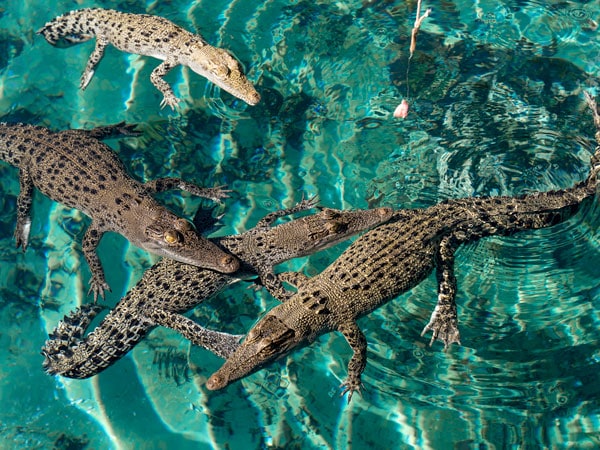
The wet season in Darwin coincides with the crocodile breeding season. (Image: Tourism NT/Tourism Australia)
Traditional owners of the Darwin area, the Larrakia people (who recognise seven main seasons) call these months Balnba (season of the first rains) and Dalay (monsoon season).
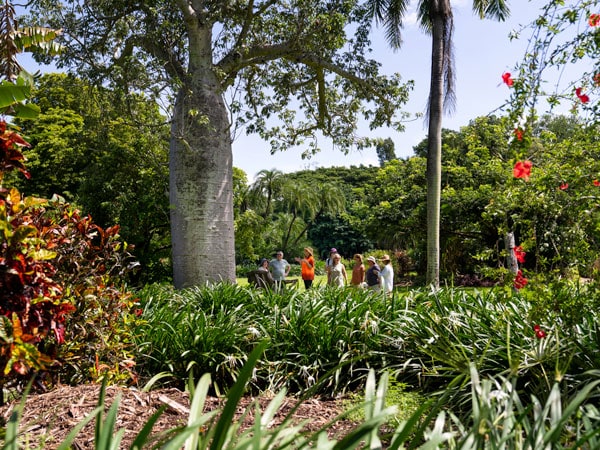
Explore the gardens on a walking tour. (Image: Tourism NT/Tourism Australia)
Dripping with flowers, lush and green – the gardens are at their best in the wet season. Start at the tranquil lily pond, before exploring the orchid house, waterfall and the mangrove community.

Stroll along the lush greenery in George Brown Darwin Botanic Gardens. (Image: Tourism NT/Nick Pincott)
For an escape from the rain, head to Eva’s Café in the heritage listed Wesleyan Church for some of Darwin’s best coffee and breakfast.
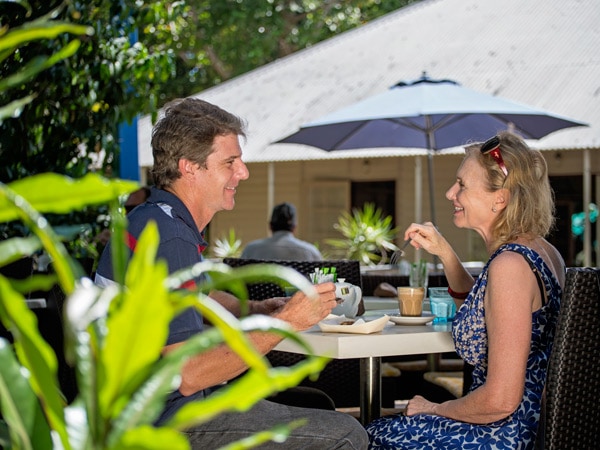
Take a break at Eva’s Café. (Image: Tourism NT/Shaana McNaught)
Exploring the WWII oil storage tunnels with its 100 wartime photographs is a unique adventure when the rain is thundering outside. Incredibly, these tunnels near Darwin’s Waterfront Precinct were hardly known until 1992, when one was opened as a tourist attraction for the 50th anniversary of the bombing of Darwin. Still today, the tunnels leak from the vast underground water supply, which adds to the adventure.
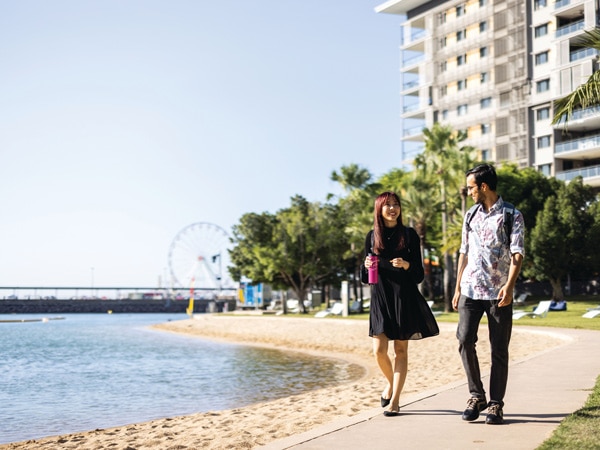
WW2 Tunnels Darwin are situated near the waterfront precinct. (Image: Tourism NT/Helen Orr)
Larrakia coastal walk takes you from Mindil Beach onto a boardwalk, through natural mangrove forest and up to Bullocky Point. In the wet season there’s plenty of crabs around, so make sure you pause on the boardwalk to look down at the creek.

Chase the sunset on Mindil Beach. (Image: Mindil Beach Markets/Kevin Phan)
Keep your eye out for painted poles indicating the uses of various Larrakia coastal plants. From here, keep walking to the Museum and Art Gallery of the Northern Territory.

The Museum and Art Gallery of the Northern Territory (MAGNT) is home to scientific and cultural collections. (Image: Tourism NT/Tourism Australia)
The build-up months (October to December) can produce the best fishing of all the seasons in the Top End. Increasing cloud cover and rainfall ignites the barra action, especially in the saltwater estuaries and the lower tidal river reaches. During the monsoonal rains (January to mid-March) barra can take a bit more hunting, but they are usually on the bite in the mangrove creeks and estuaries around Darwin Harbour.
Fishing over the wet season gives you the opportunity to win big. The Northern Territory Government’s Million Dollar Fish has tagged barra to catch worth $1 million (make sure you’re registered before you go fishing).

Try your luck and catch some fish in Darwin. (Image: Tourism NT/Helen Orr)
It may be wet season but there are still markets to explore. Head to the Rapid Creek Markets on the weekend for tropical fruits and fresh juice; or check out Parap Village Markets to try one of Mary’s award-winning laksa soups.

Pick fresh mangoes at Parap Village Markets. (Image: Tourism Australia/Nicholas Kavo)
Over at Nightcliff Markets, locals dine on warm Nutella crepes and fresh rice paper rolls. From late October onwards, mangoes are plentiful -but be warned, you might find the mango smoothies and mango sticky rice a bit addictive.

Don’t miss out on Mary’s award-winning laksa soups. (Image: Tourism NT/Matt Cherubino)
Heavy rains mean the waterfalls in Litchfield National Park and Kakadu are at their most impressive, particularly from November onwards. One of the best ways to see them and get an appreciation for their size and power is by stepping aboard a scenic flight.

Jim Jim Falls looks spectacular from above. (Image: Tourism NT/@helloemilie)
For wet season guides check out Ethical Adventures’ Pure Litchfield tour or take a private tour with Venture North to Litchfield, Katherine and Kakadu.
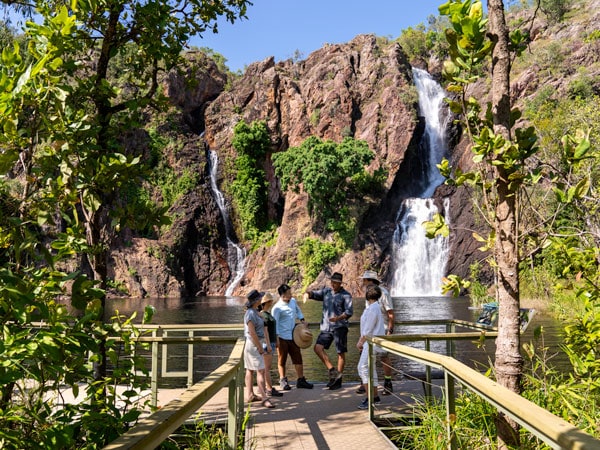
Tour the majestic sights at Litchfield National Park with Ethical Adventures. (Image: Tourism NT/Shaana McNaught)
For a perfect wet season night out head along to the Darwin Entertainment Centre to catch a show, such as Jessica Mauboy or The Teskey Brothers, or a movie as part of Flix in the Wet. You might want to dine next door at Hanuman, one of the best restaurants in Darwin before trotting off to one of Darwin’s top city hotels for a night cap.

Dine next door at Hanuman. (Image: Tourism NT)
One of the most accessible places to see the wetlands and wildlife over the wet season is at Fogg Dam, a 45-minute drive from Darwin. A haven for water pythons, freshwater turtles and birds, Fogg Dam is famous among naturalists for having one of the world’s highest biomass of predator (water pythons) to prey (dusky rats) ratio.
For a stunning panoramic view of the Adelaide River floodplain, head to Wetland Top View Centre, an hours’ drive from Darwin on the way to Kakadu. Run by Aboriginal-owned tourism venture Pudakul Aboriginal Cultural Tours, the two-level visitor centre building, constructed to represent the form of a dancing brolga, is complete with amenities, cafe, and interactive display with the top-level viewing deck providing an uninterrupted view of the wetlands.